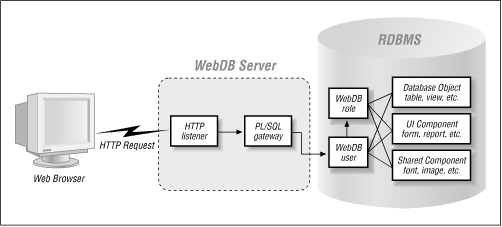WebDB Architecture
Because WebDB uses the database’s native components, it is a scalable, powerful development tool for building content-driven sites on Oracle. Since it’s essentially written in the database’s native language, it eliminates the need for cumbersome layers like ODBC or JDBC.
WebDB’s dirty little secret is that its wizards are really just PL/SQL code generators that act on normal database objects. When you create a user with WebDB, you are really creating a corresponding database schema, just as you would for any other Oracle user. When you use the table wizard, you are really just filling in the pieces of a CREATE TABLE command. When you build a form, you are really creating a PL/SQL package. The options you enter into these wizards tell WebDB how to create the corresponding database objects.
WebDB is a standalone product that contains everything you need to create a complete application. Two built-in components—the PL/SQL gateway and the HTTP listener—make this possible. Figure 3.9 illustrates the relationships among the database objects, UI components, shared components, roles, users, the PL/SQL gateway, and the HTTP listener.

Figure 3-9. The components of WebDB
In the following sections, we’ll look at WebDB’s PL/SQL gateway and its integrated HTTP listener.
The PL/SQL Gateway
Once we’ve created our WebDB user interface components, we can use the PL/SQL gateway to execute ...
Get Oracle Web Applications: PL/SQL Developer's Intro now with the O’Reilly learning platform.
O’Reilly members experience books, live events, courses curated by job role, and more from O’Reilly and nearly 200 top publishers.

